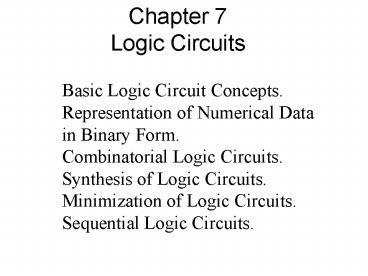Chapter 7 Logic Circuits PowerPoint PPT Presentation
1 / 75
Title: Chapter 7 Logic Circuits
1
Chapter 7Logic Circuits
Basic Logic Circuit Concepts. Representation of
Numerical Data in Binary Form. Combinatorial
Logic Circuits. Synthesis of Logic Circuits.
Minimization of Logic Circuits. Sequential
Logic Circuits.
2
Chapter 7Logic Circuits
- State the advantages of digital technology
compared to analog technology. - 2. Understand the terminology of digital
circuits. - 3. Convert numbers between decimal, binary, and
- other forms.
3
5. Understand the binary arithmetic operations
used in computers and other digital systems. 6.
Interconnect logic gates of various types to
implement a given logic function. 7. Use
Karnaugh maps to minimize the number of gates
needed to implement a logic function. 8.
Understand how gates are connected together to
form flip-flops and registers.
4
(No Transcript)
5
(No Transcript)
6
(No Transcript)
7
Advantages of the Digital Approach
Provided that the noise amplitude is not too
large, the logic values represented by a digital
signal can still be determined after noise is
added. With modern IC technology, it is possible
to manufacture exceedingly complex digital
circuits economically.
8
Definitions
Positive versus Negative Logic Digital Words In
parallel transmission, an n-bit word is
transferred on n wires, one wire for each bit,
plus a common or ground wire. In serial
transmission, the successive bits of the word are
transferred one after the other with a single
pair of wires.
9
Binary Numbers
10
(No Transcript)
11
(No Transcript)
12
(No Transcript)
13
(No Transcript)
14
(No Transcript)
15
(No Transcript)
16
Gray Code
17
(No Transcript)
18
(No Transcript)
19
(No Transcript)
20
Complement Arithmetic
The ones complement of a binary number is
obtained by replacing 1s by 0s, and vice versa.
01001101 10110010 (ones complement)
21
The twos complement of a binary number is
obtained by adding 1 to the ones complement,
neglecting the carry (if any) out of the most
significant bit. Complements are useful for
representing negative numbers and performing
subtraction in computers.
22
Subtraction Using Twos-Complement Arithmetic
23
Overflow and Underflow
In performing arithmetic using twos-complement
arithmetic, we must be aware of the possibility
of overflow in which the result exceeds the
maximum value that can be represented by the word
length in use.
24
(No Transcript)
25
(No Transcript)
26
(No Transcript)
27
(No Transcript)
28
(No Transcript)
29
(No Transcript)
30
(No Transcript)
31
(No Transcript)
32
(No Transcript)
33
Boolean algebra expressions can be implemented by
interconnection of AND gates, OR gates, and
inverters.
34
(No Transcript)
35
(No Transcript)
36
De Morgans Laws
If the variables in a logic expression are
replaced by their inverses, the AND operation is
replaced by OR, the OR operation is replaced by
AND, and the entire expression is inverted, the
resulting logic expression yields the same values
as before the changes.
37
(No Transcript)
38
NAND, NOR, and XOR Gates
39
(No Transcript)
40
(No Transcript)
41
Sum-of-Products Implementation
Product terms that include all of the input
variables (or their inverses) are called
minterms. In a sum-of-products expression, we
form a product of all the input variables (or
their inverses) for each row of the truth table
for which the result is logic 1. The output is
the sum of these products.
42
(No Transcript)
43
(No Transcript)
44
Product-of-Sums Implementation
Sum terms that include all of the input variables
(or their inverses) are called maxterms. In a
product-of-sums expression, we form a sum of all
the input variables (or their inverses) for each
row of the truth table for which the result is
logic 0. The output is the product of these sums.
45
(No Transcript)
46
(No Transcript)
47
(No Transcript)
48
(No Transcript)
49
(No Transcript)
50
Many useful combinatorial circuits known as
decoders, encoders, or translators are available
as integrated circuits.
51
(No Transcript)
52
(No Transcript)
53
Karnaugh Maps
54
(No Transcript)
55
(No Transcript)
56
(No Transcript)
57
(No Transcript)
58
(No Transcript)
59
(No Transcript)
60
(No Transcript)
61
(No Transcript)
62
(No Transcript)
63
(No Transcript)
64
(No Transcript)
65
(No Transcript)
66
(No Transcript)
67
(No Transcript)
68
(No Transcript)
69
(No Transcript)
70
(No Transcript)
71
(No Transcript)
72
(No Transcript)
73
(No Transcript)
74
(No Transcript)
75
(No Transcript)

